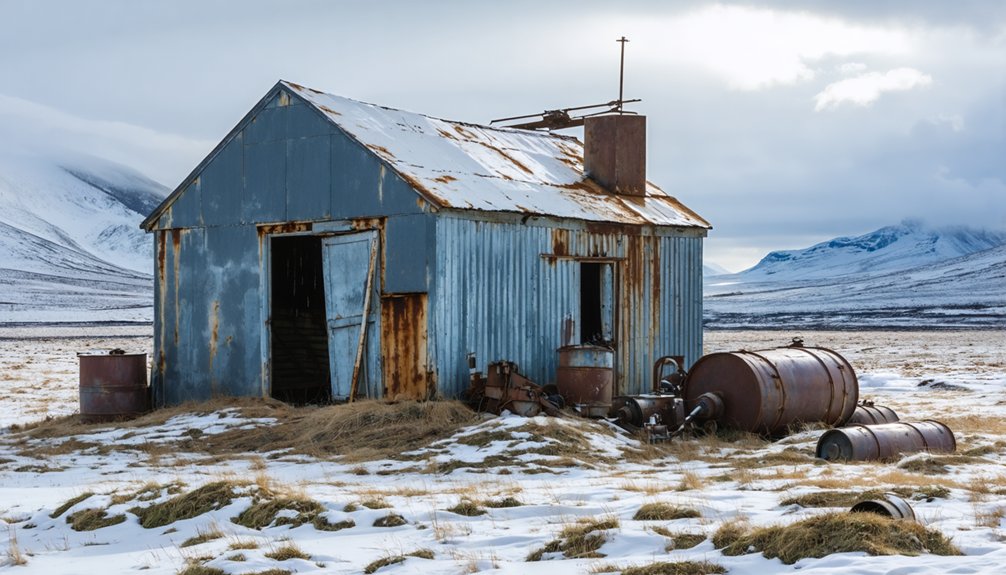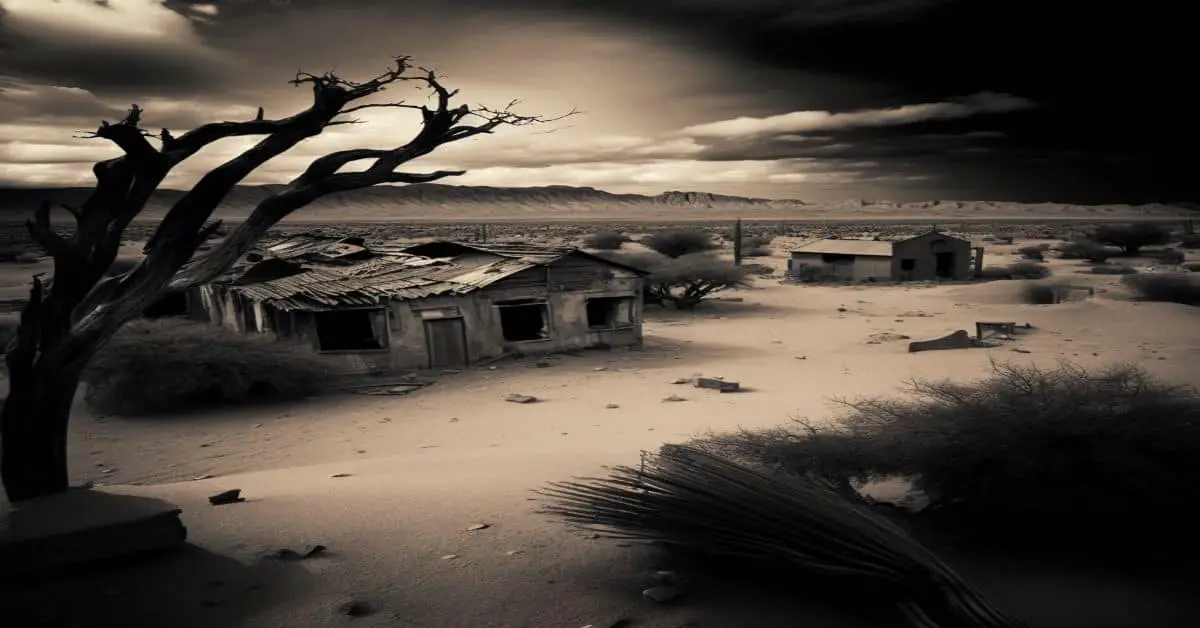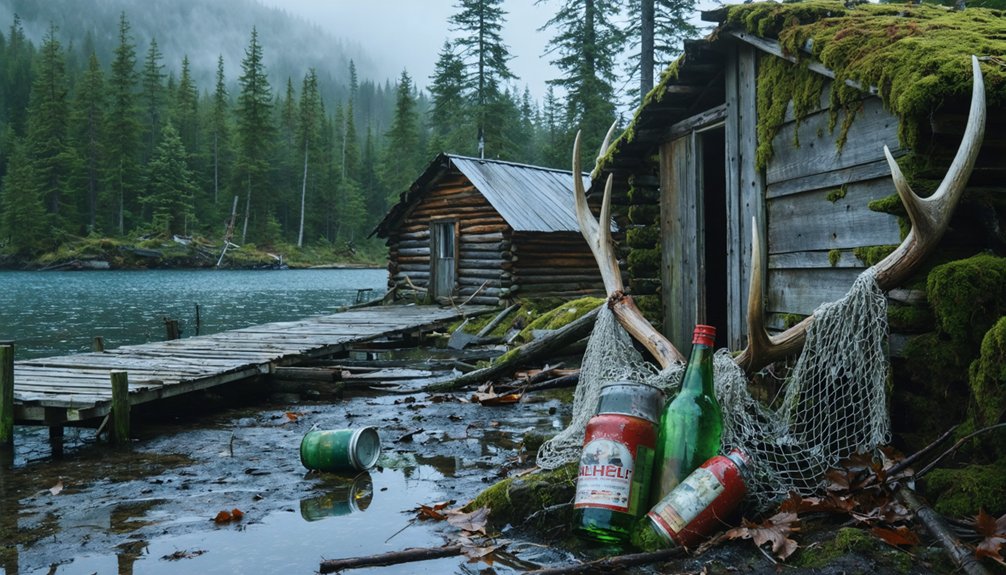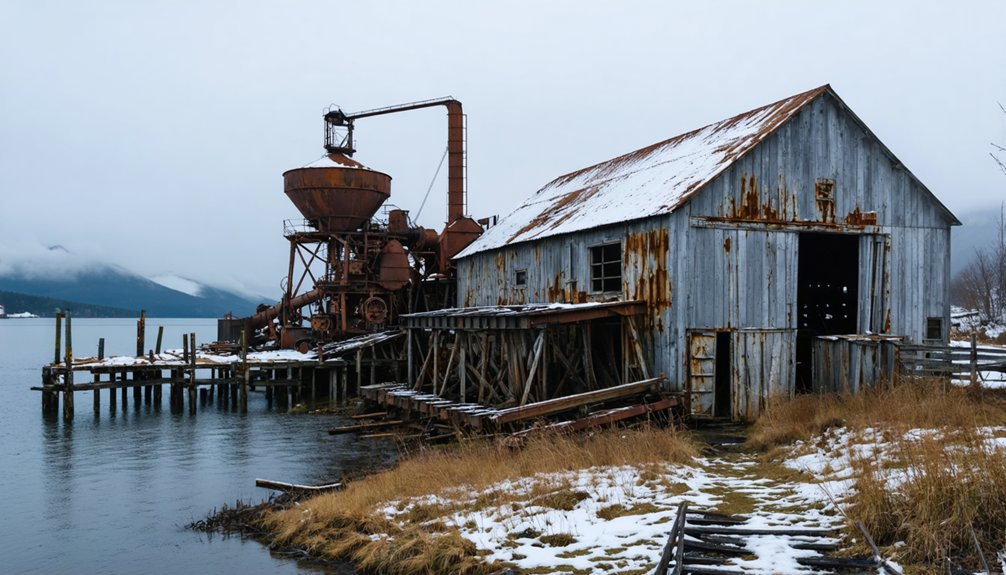You’ll find Tin City, Alaska, at 65 degrees north latitude, where prospectors discovered placer tin at Buhner Creek in 1900. The settlement flourished briefly after W.C.J. Bartels found additional tin lodes in 1902, leading to a $500,000 investment in mining operations and a post office by 1904. Despite producing 3.3 million pounds of tin from Cape Creek deposits, the town’s promising future faded by 1909. The site’s remaining structures tell a compelling tale of frontier ambition and harsh reality.
Key Takeaways
- Tin City emerged in 1902 after tin discoveries but quickly declined by 1909, becoming a ghost town due to limited ore yields.
- The remote settlement featured scattered houses near Cape Creek and a mining camp at Cape Mountain’s base.
- Despite $500,000 investment in mining operations, only 536 tons of metallic tin were extracted by 1914.
- The town’s peak occurred in 1907 with two operating companies and a 10-stamp mill before economic challenges forced closures.
- Today, only remnants of the 10-stamp mill and a radar station remain as evidence of this former frontier mining settlement.
The Discovery That Started It All
In 1900, prospectors made a groundbreaking discovery of placer tin at Buhner Creek, marking the first documented tin find in Alaska’s history.
Located at the western edge of the Seward Peninsula, this discovery held immense potential to challenge Great Britain’s dominance of global tin markets, which primarily came from Cornwall and Malaya.
The significance of the placer deposits prompted immediate action from the U.S. Geological Survey, which verified the discovery that same year.
The U.S. Geological Survey swiftly responded to verify these significant placer deposits, recognizing their potential impact on American mineral resources.
By 1902, W.C.J. Bartels had discovered additional tin lodes in the region, leading to the establishment of a mining company in 1903.
This sparked extensive underground work at the Cape Mountain prospect, where you’d have found growing operations shipping ore and developing infrastructure that would soon transform this remote Alaskan wilderness.
Like the sudden abandonment seen at Kennicott, where dinner tables sat untouched, Tin City’s infrastructure remained frozen in time when operations ceased.
The mining settlement grew quickly, leading to the opening of a Tin City post office in 1904 to serve the bustling community.
Life in a Remote Mining Settlement
Located at one of Alaska’s most remote outposts, Tin City presented extraordinary challenges for the hardy miners who called it home in the early 1900s.
You’d find yourself facing harsh conditions year-round, with Arctic winds whipping off the Bering Sea and limited access to basic supplies. The settlement’s few scattered houses near Cape Creek offered minimal protection from the elements, while the mining camp at Cape Mountain’s base provided basic necessities for workers. Throughout its operational years, the area produced 3.3 million pounds of tin from Cape Creek deposits. The area’s rich deposits of cassiterite mineral drew prospectors to this harsh environment.
Despite its isolation, community resilience emerged through shared challenges.
You’d rely on shipments from distant ports for essential supplies, and the local post office, established in 1904, served as a crucial lifeline to the outside world.
Medical emergencies proved particularly challenging, as you’d need to navigate vast distances for healthcare access.
Mining Operations and Economic Dreams
Three ambitious mining ventures launched Tin City’s economic aspirations following W.C.J. Bartels’ discovery of tin ore in 1902.
You’d have witnessed massive investment efforts, with approximately $500,000 (equivalent to $15 million today) poured into establishing sophisticated mining techniques, including a 10-stamp mill and plans for a five-stack smelter.
Despite grand visions of producing 50 tons of refined tin daily, the reality proved far more modest.
Mining operations employed both underground lode mining and placer dredging, with shafts extending 400 feet deep.
Yet by 1914, only 536 tons of metallic tin had been extracted.
Economic challenges, including complex geology, remote location, and inadequate tin prices, ultimately subdued these ambitious ventures.
Most concentrate was shipped abroad for smelting, as local operations couldn’t sustain profitability.
The site later gained strategic importance when the Tin City Station was established in 1950 as a Cold War defense facility.
The Swift Rise and Fall
While W.C.J. Bartels’ discovery of tin ore in 1902 sparked initial excitement, you’ll find that Tin City’s trajectory exemplifies the fleeting nature of mining dreams.
By 1903, a determined group established a mining camp, and within a year, you could’ve found a functional post office serving the burgeoning settlement. Just as economic shifts affected Portlock’s decline, Tin City faced similar challenges. The town’s zenith arrived in 1907, when you’d have witnessed two companies operating a 10-stamp mill, processing ore with high hopes of striking it rich.
Yet mining challenges quickly dampened these aspirations. Economic shifts proved harsh as limited ore yields and competition from nearby Lost River undermined profitability.
You’d have seen the town’s swift decline marked by the post office’s closure in 1909, leaving behind scattered houses and abandoned equipment until the military repurposed the site in 1950.
Legacy and Present-Day Remnants
Today, Tin City’s most prominent legacy stands as a tribute to both its mining aspirations and Cold War significance.
You’ll find this ghost town’s historical significance deeply rooted in Alaska’s resource extraction heritage and national defense strategy. Located at 65 degrees north latitude, Tin City represents one of the northernmost mining settlements in American history. Like many gold rush boomtowns, it experienced the familiar cycle of rapid growth and eventual abandonment. The cultural heritage of this remote outpost lives on through its remaining structures and the stories they tell.
When you visit this abandoned settlement near Cape Prince of Wales, you’ll discover:
- A radar station that once served as a crucial Cold War defense installation
- Scattered remnants of mining infrastructure, including parts of the 10-stamp mill
- The harsh Arctic environment that challenged early settlers’ dreams of tin independence
- A strategic location that offers unparalleled views of the Bering Sea coast
The site now stands as a monument to human perseverance in one of North America’s most isolated frontiers.
Frequently Asked Questions
What Wildlife Was Commonly Encountered by Tin City’s Early Residents?
Like nature’s buffet laid before you, you’d encounter seals, walruses, and various gulls during coastal wildlife encounters, while reindeer herding and hunting practices targeted caribou and arctic foxes inland.
How Did Residents Cope With Extreme Winter Conditions in Tin City?
You’d survive through winter by staying in buildings connected by heated portals, relying on diesel power, adapting work schedules, and maintaining strict snow management protocols—showcasing remarkable community resilience against brutal conditions.
Were There Any Schools or Churches Established During Tin City’s Peak?
As bare as a winter branch, you’ll find no evidence of education facilities or religious establishments during Tin City’s peak. The small, transient population couldn’t support permanent schools or churches.
What Was the Maximum Population Reached During Tin City’s Mining Boom?
While exact Tin City demographics weren’t documented during the mining boom, you’ll find historical evidence suggests the population likely peaked at several hundred people at most between 1903-1907.
Did Any Major Accidents or Disasters Occur in Tin City’s Mines?
You won’t find evidence of major mine accidents or disasters in Tin City’s operations. Despite challenging conditions in early 1900s underground mining, historical records don’t indicate any significant disaster impact or fatalities.
References
- https://live.laborstats.alaska.gov/sites/default/files/trends/may24art2_0.pdf
- https://coastview.org/2024/08/21/tin-city-seward-peninsula/
- https://www.miningnewsnorth.com/story/2019/08/01/northern-mining-history/the-hope-of-a-nation-within-tin-city/5847.html
- https://alaska.guide/village/tin-city
- https://en.wikipedia.org/wiki/List_of_ghost_towns_in_Alaska
- https://everafterinthewoods.com/forgotten-ghost-towns-in-alaska-that-are-as-isolated-as-they-are-stunning/
- https://pubs.usgs.gov/bul/0692g/report.pdf
- https://kids.kiddle.co/Tin_City
- https://www.youtube.com/watch?v=Cz0IGc2Uy0E
- https://www.youtube.com/watch?v=NsI8bIhJ2pA



